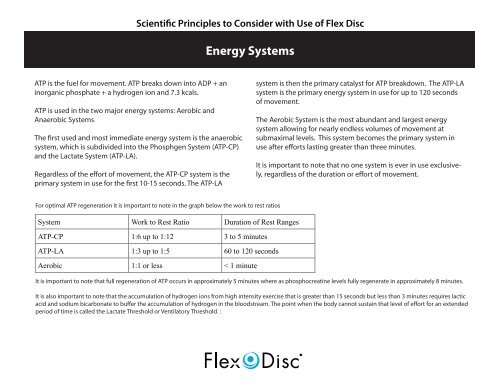FDM Flipbook
You also want an ePaper? Increase the reach of your titles
YUMPU automatically turns print PDFs into web optimized ePapers that Google loves.
Scientific Principles to Consider with Use of Flex Disc<br />
Energy Systems<br />
ATP is the fuel for movement. ATP breaks down into ADP + an<br />
inorganic phosphate + a hydrogen ion and 7.3 kcals.<br />
ATP is used in the two major energy systems: Aerobic and<br />
Anaerobic Systems<br />
The first used and most immediate energy system is the anaerobic<br />
system, which is subdivided into the Phosphgen System (ATP-CP)<br />
and the Lactate System (ATP-LA).<br />
Regardless of the effort of movement, the ATP-CP system is the<br />
primary system in use for the first 10-15 seconds. The ATP-LA<br />
system is then the primary catalyst for ATP breakdown. The ATP-LA<br />
system is the primary energy system in use for up to 120 seconds<br />
of movement.<br />
The Aerobic System is the most abundant and largest energy<br />
system allowing for nearly endless volumes of movement at<br />
submaximal levels. This system becomes the primary system in<br />
use after efforts lasting greater than three minutes.<br />
It is important to note that no one system is ever in use exclusively,<br />
regardless of the duration or effort of movement.<br />
For optimal ATP regeneration it is important to note in the graph below the work to rest ratios<br />
System Work to Rest Ratio Duration of Rest Ranges<br />
ATP-CP 1:6 up to 1:12 3 to 5 minutes<br />
ATP-LA 1:3 up to 1:5 60 to 120 seconds<br />
Aerobic 1:1 or less < 1 minute<br />
It is important to note that full regeneration of ATP occurs in approximately 5 minutes where as phosphocreatine levels fully regenerate in approximately 8 minutes.<br />
It is also important to note that the accumulation of hydrogen ions from high intensity exercise that is greater than 15 seconds but less than 3 minutes requires lactic<br />
acid and sodium bicarbonate to buffer the accumulation of hydrogen in the bloodstream. The point when the body cannot sustain that level of effort for an extended<br />
period of time is called the Lactate Threshold or Ventilatory Threshold. :<br />
R






